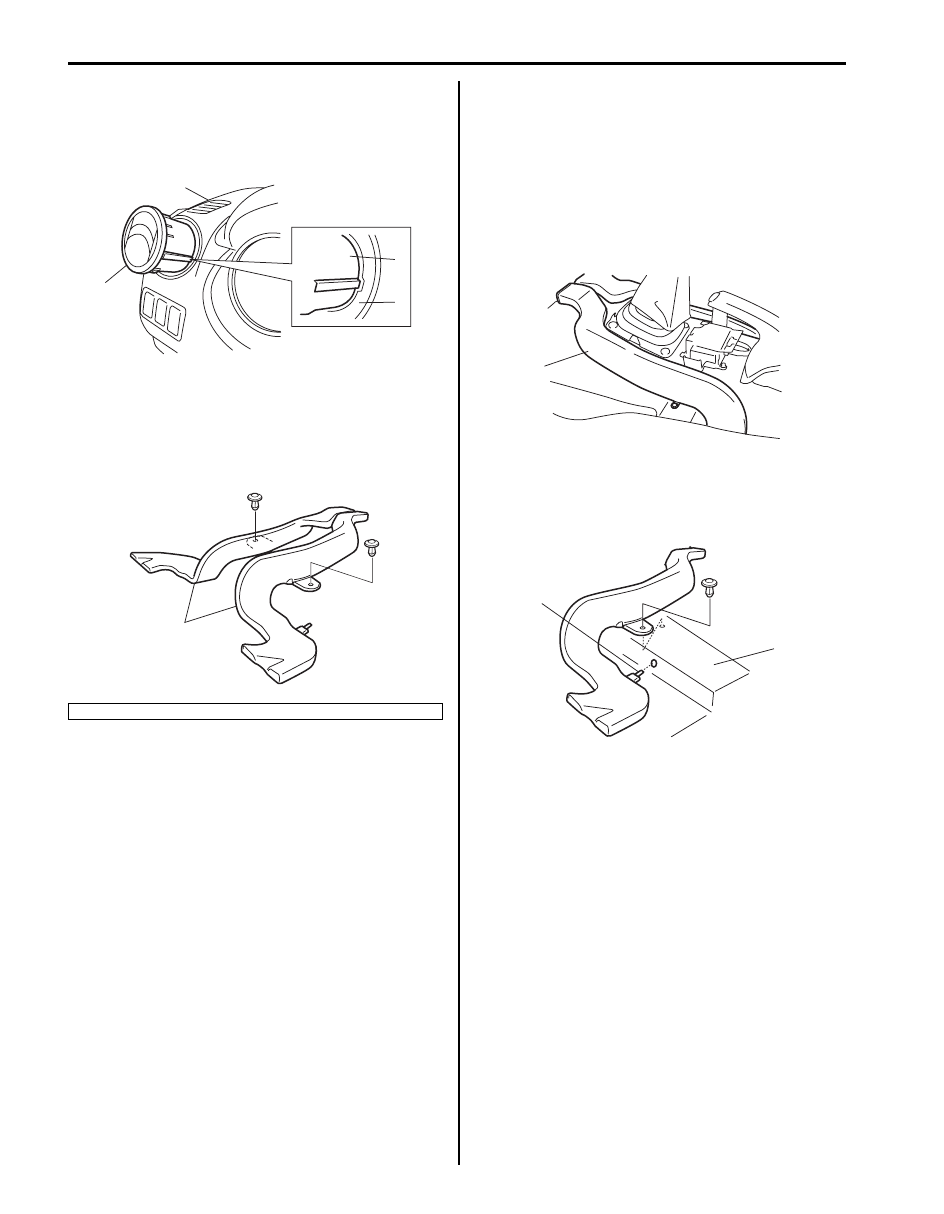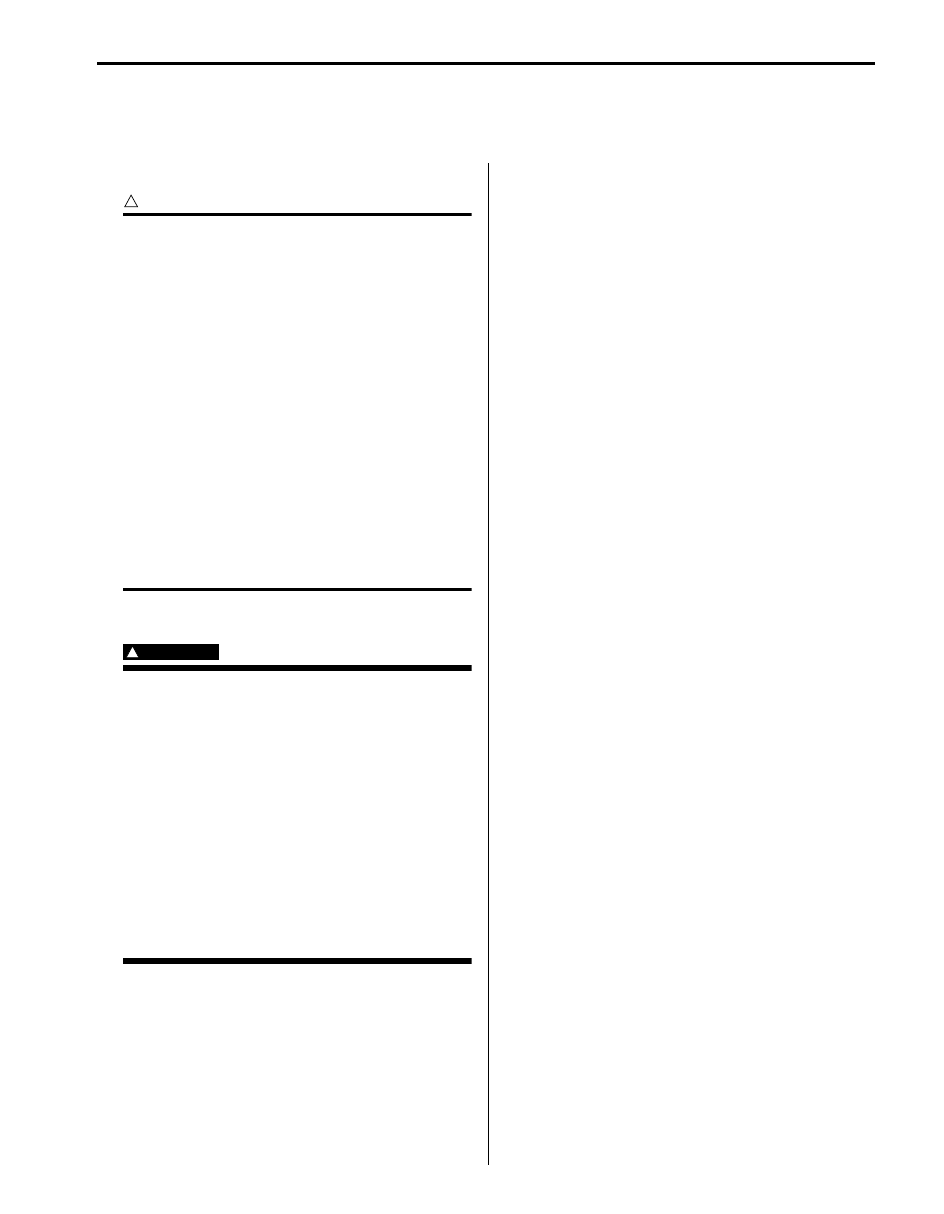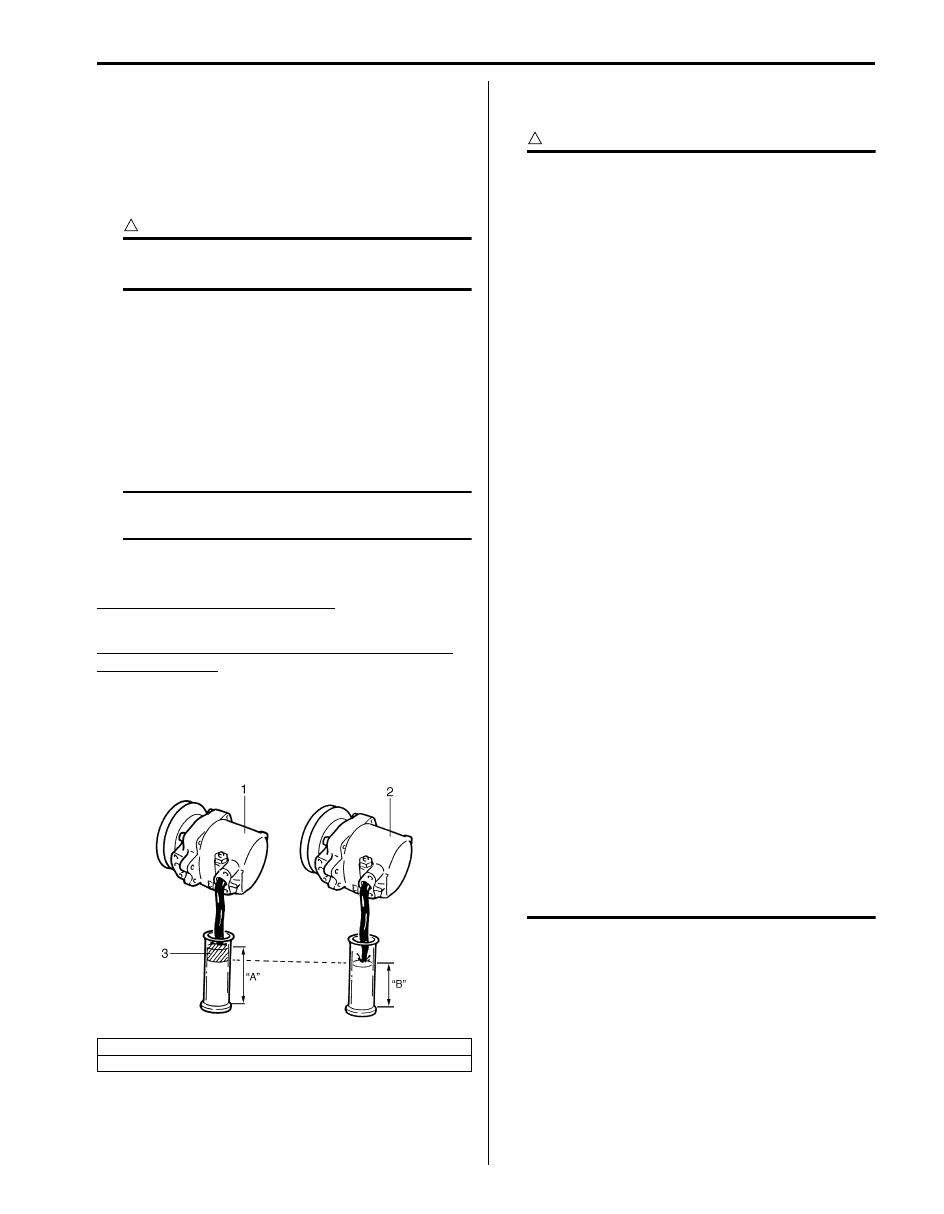Suzuki Grand Vitara JB627. Manual — part 271

7A-16 Heater and Ventilation:
Installation
1) Reverse removal procedure, noting the following.
• Install side ventilation louver (1) to instrument
panel (2) as shown in figure.
• When installing defroster duct to instrument panel,
put claws of defroster duct into hole of ventilator
duct surely.
Rear Duct Components
S6JB0B7106022
Rear Duct Removal and Installation
S6JB0B7106023
Removal
1) Disconnect negative (–) cable at battery.
2) Remove front seats.
3) Remove console box.
4) Take off carpet till rear ducts is totally exposed.
5) Remove rear ducts (1).
Installation
Reverse removal procedure noting the following.
• Insert boss (1) of duct into hole of floor member (2).
1. Rear duct
1
2
1
2
I5JB0A710024-02
1
I5JB0A710025-02
1
I5JB0A710026-01
2
1
I5JB0A710027-01

Air Conditioning System: 7B-1
HVAC
Air Conditioning System
Precautions
A/C System Caution
S6JB0B7200001
CAUTION
!
The air conditioning system of this vehicle
uses refrigerant HFC-134a (R-134a).
None of refrigerant, compressor oil and
component parts is interchangeable between
two types of A/C: one using refrigerant HFC-
134a (R-134a) and the other using refrigerant
CFC-12 (R-12).
Be sure to check which refrigerant is used
before any service work including inspection
and maintenance. For identification between
these two types, refer to “A/C Refrigerant
Type Description”.
When replenishing or changing refrigerant
and compressor oil and when replacing
parts, make sure that the material or the part
to be used is appropriate to the A/C installed
in the vehicle being serviced.
Use of incorrect one will result in leakage of
refrigerant, damage in parts or other faulty
condition.
Precautions on Servicing A/C System
S6JB0B7200002
WARNING
!
Should refrigerant HFC-134a (R-134a) is
exposed to your eye(s), consult a doctor
immediately.
• Do not use your hand to rub affected
eye(s). Instead, use fresh cold water to
splash it over affected area to thus
gradually raise its temperature above the
freezing point.
• Obtain proper treatment as soon as
possible from a doctor or eye specialist.
Should liquid refrigerant HFC-134a (R-
134a) is exposed to your skin, such
affected part should be treated in the same
manner as when skin is frostbitten or
frozen.
Precautions in Diagnosing Trouble
S6JB0B7200003
• Do not disconnect connector from HVAC control
module, battery cable from battery, or main fuse
before reading diagnostic information stored in HVAC
control module memory.
• When diagnosing vehicle indoors, sunload sensor has
to be lighted over vertically with an incandescent light.
Otherwise, DTC is detected even if sunload sensor is
normal.
• Diagnostic information (diagnostic trouble code)
stored in HVAC control module can be checked by
display of HVAC control module. Also, it can be
checked by using SUZUKI scan tool. Before checking
diagnostic information (diagnostic trouble code), read
this manual and operator’s manual for SUZUKI scan
tool to know how to read diagnostic information
(diagnostic trouble code).
• When trouble is diagnosed using diagnostic
information (diagnostic trouble code) on display of
HVAC control module, keep in your mind that each
diagnostic information (diagnostic trouble code) has
priority, and only diagnostic information (diagnostic
trouble code) which has the highest priority is
indicated. Therefore, after troubleshooting the
malfunction, make sure if there exists any other
diagnostic information (diagnostic trouble code).
• After troubleshooting some trouble, DTC can be
stored in HVAC control module memory as history
DTC.
• Be sure to read “Precautions for Electrical Circuit
Service” before inspection.
Precautions on Handling Refrigerant HFC-134a
(R-134a)
S6JB0B7200004
• When handling refrigerant, always wear goggles to
protect your eyes.
• Avoid you direct contact to liquid refrigerant.
• Do not heat refrigerant container higher than 40
°C
(104
°F).
• Do not discharge refrigerant into atmosphere.
• Do not allow liquid refrigerant to touch bright metals.
Refrigerant combined with moisture is corrosive and
will tarnish surfaces of bright metals including chrome.
• After recovering refrigerant from system, the amount
of compressor oil removed must be measured and the
same amount added to the system.

7B-2 Air Conditioning System:
Precautions on Servicing Refrigerant Line
S6JB0B7200005
• When connecting hoses and pipes, apply a few drops of compressor oil (refrigerant oil) to seats of coupling nuts
and O-ring.
• Never use heat for bending pipes. When bending a pipe, try to make its bending radius as slight as possible.
• Keep internal parts of air conditioning free from moisture and dirt. When disconnecting any line from system, install
a blind plug or cap to the fitting immediately.
• When tightening or loosening a fitting, use two wrenches, one for turning and the other for support.
• Tighten bolts to specified torque.
Tightening torque
Refrigerant line bolt: 12 N·m (1.2 kgf-m, 9.0 lb-ft)
• Route drain hose so that drained water does not make any contact to vehicle components.
Precautions on Refrigerant Recovery
S6JB0B7200006
When discharging refrigerant out of A/C system, always
recover it by using refrigerant recovery and recycling
equipment. Discharging refrigerant HFC-134a (R-134a)
into atmosphere would cause adverse effect to
environments.
NOTE
When handling recovery and recycling
equipment, be sure to follow the instruction
manual for the equipment.
Precautions on Refrigerant Charge
S6JB0B7200007
Charge a proper amount of refrigerant to A/C system
according to charging procedure described in recovery,
evacuation and charging. Refer to “Charge” in
“Operation Procedure for Charging A/C with
Refrigerant”.
Precautions on Replenishing Compressor Oil
S6JB0B7200008
When replacing air conditioning parts with new ones, it is
necessary to replenish oil by the amount supposedly
remaining in each part.
4
OIL
1
OIL
2
OIL
3
OIL
5
OIL
[A]
1
OIL
2
OIL
4
OIL
3
OIL
5
OIL
[B]
I6JB0B720003-02
[A]: LHD model
3. Liquid pipe
[B]: RHD model
4. Expansion valve
1. Suction hose
5. Pressure sensor
2. Discharge hose
: Apply compressor oil (refrigerant oil) to O-ring.

Air Conditioning System: 7B-3
When Charging Refrigerant Only
When charging refrigerant without replacing any
component, replenish the same amount of measured oil
when recovering refrigerant (if not measure, replenish 20
cm
3
(20 cc) oil).
When Replacing Compressor
CAUTION
!
Be sure to use specified compressor oil or an
equivalent compressor oil.
Compressor oil is sealed in each new compressor (1) by
the amount required for air conditioner cycle. Therefore,
when using a new compressor for replacement, drain oil
from it by the amount calculated as follows.
“C” = “A” – “B”
“C”: Amount of oil to be drained
“A”: Amount of oil sealed in a new compressor
“B”: Amount of oil remaining in removed
compressor
NOTE
Compressor assembly supplied from factory
is filled up with the following amount of oil.
: Compressor oil 99000–99022–00E (Compressor oil
(DH-PS, 250cc))
Amount of oil in new compressor
: 150 (+20, –0) cm
3
(150 (+20, –0) cc)
Amount of compressor oil to be replenished after
part replacement
Evaporator: 50 cm
3
(50 cc)
Condenser: 30 cm
3
(30 cc)
Receiver/dryer: 10 cm
3
(10 cc)
Hoses: 10 cm
3
(10 cc)
Pipes: 10 cm
3
(10 cc)
Precautions on Servicing Compressor
Assembly
S6JB0B7200009
CAUTION
!
• None of refrigerant, compressor oil and
component parts is interchangeable
between two types of A/C: one using CFC-
12 (R-12) and the other using HFC-134a (R-
134a).
For identification between these two types,
refer to “A/C Refrigerant Type
Description”.
When replenishing or changing refrigerant
and compressor oil and when replacing
parts, make sure that the material or the
part to be used is appropriate to the A/C
installed in the vehicle being serviced. Use
of incorrect refrigerant or compressor oil
will result in leakage of refrigerant, damage
in parts or other faulty condition.
• When servicing the compressor, keep dirt
or foreign material away from getting on or
into the compressor parts and system.
Clean tools and a clean work area are
important for proper service.
The compressor connection and the
outside of the compressor should be
cleaned before any “On-vehicle” repair or
before removal of the compressor. The
parts must be kept clean at all times and
any parts to be reassembled should be
cleaned with trichloromethane, naphtha,
kerosene or equivalent solvent and dried
with dry air. Use only lint free cloths to
wipe parts.
• When compressor is removed from the
vehicle for servicing, the oil remaining in
the compressor should be discarded and
new refrigerant oil added to the
compressor.
Minor repair procedures may be done on
the vehicle without discharging the
system. Major repair procedures require
that the system be discharged of
refrigerant.
2. Removed compressor
3. Excess oil (A – B)
I5JB0A720003-01

Нет комментариевНе стесняйтесь поделиться с нами вашим ценным мнением.
Текст